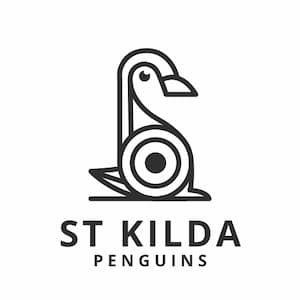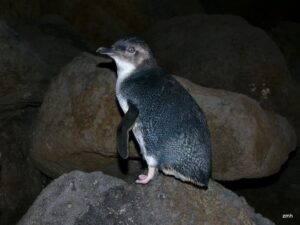Do Little Penguins respond to the Lunar Cycle?
The following is a brief introduction to the topic:
Little penguins usually leave their burrows at dawn to forage on the sea, returning after dark (Stahel & Gales, 1987; Reilly 1994). This diurnal pattern of foraging reflects that penguins use their vision to find prey. (Cannell & Cullen, 1998) Some little penguins, however, remain at sea overnight or take long-term journeys of up to three days from their burrow. (Weavers 1992; Collins and al. 1999). The number of penguins that stay at sea overnight could increase in certain conditions. This includes increased light levels caused by a full-moon. A full moon could provide enough light for penguins to stay out at sea and forage. Some seabirds such as the albatross increase their activity when there is a full Moon. In a study of environmental factors influencing the by-catch rate of Japanese fishing boats in Australian waters (Klair & Polacheck 1998), it was found that seabirds were five times more likely to be caught on full moon than new moon night.
Little penguins may also be able to forage more during full moon night, but the need to return to their burrows to mate, to incubate the eggs, or to feedthe chicks, could prevent this during breeding season. Moulting penguins are also required to stay in burrows during this time (Stahel & Gales, 1987). Data from the St Kilda Pier little penguin colony, collected between the years 1986 and 2003, were analysed to test the hypothesis. In order to test the hypothesis that more penguins stay out at sea during full moon nights there should be less penguins at the colony, taking into consideration the differences between the breeding/moulting season and the non-breeding seasons.
Methods
Since 1986, the numbers of little penguins have been regularly recorded (approx. Since 1986, St Kilda Pier has been recording little penguin numbers twice a week. This data allowed me to determine the average number adult penguins captured during each phase of the moon. Each sampling date corresponded to a specific moon phase. According to the closest moon phase, each sampling date was assigned to a particular moon phase (i.e. (Moon phase dates were sourced from http://www.timeanddate.com/calender/).
In order to determine if breeding or moulting activities had an impact on the number of penguins at sea, each sampling date was classified into the breeding/moulting or non-breeding seasons. ANOVA was used to analyze the effects of the moon phase, season and any interactions between these factors on the penguin population at the colony.
Results
The number of penguins captured at the colony during full moon nights did not differ significantly from other nights (F=1.33, p=0.264). On full moon nights there were an average of 11,9 adult penguins, compared to 13,6 during the first quarter, 12,8 during the last quarter, and 12,7 on new moon night.
During the breeding/moulting seasons, there were significantly more penguins, with an average of 14.3, as opposed to only 10.4 during the non-breeding period (F=33.65; p0.001). The interaction between seasonal factors and moon phase was not significant (F=0.04, P=0.99).
Discussion and conclusion
According to data collected at the St Kilda Pier colony, little penguins don’t appear to respond to lunar cycles. It is possible that other factors such as relative cloud coverage have obscured the response. Cloudy nights could counteract a brightly lit moon and cause penguins, who would otherwise stay at sea, to return to the burrows. Little penguins are known to take long trips lasting three days or longer during non-breeding seasons. This complicates analysis (Weavers 1992; Collins and al. 1999). These penguins will be absent, whether they are foraging because of the moon or not. Cannel & Cullen’s (1998) study of Little Penguins foraging behavior at different light levels suggests that the penguins would not be able to forage during nighttime, even with a full-moon. This study determined that little penguins need a minimum light level between 0.6-6.1 Lux to locate prey. However, the light intensity during a clear night with a fully moon is only 0.12-0.22 Lux (Andreadis 1997; Cannell & Cullen 1998). Insufficient light is needed to find prey on full moon nights, so little penguins are unlikely to stay at sea.
References
Andreadis, P. (1997). “A lunar rhythm of foraging activity in Northern water snakes.” Scott, A.
Cannell, B., and Cullen J. (1998). The foraging behavior of Little Penguins Eudyptula Minorat various light levels.” Ibis 140: 467-471.
Collins, M. Cullen, J. & Dann, P. “Seasonal foraging movements and annual movements of little penguins on Phillip Island, Victoria.” Wildlife Research 26 : 705-721.
Klair, N., and Polacheck T. The influence of environmental factors on the by-catch rate of seabirds caught by Japanese longline vessels in Australia. Emu 95 : 306-316.
Reilly, P. (1994). Penguins of the World. Oxford University Press Melbourne.
Stahel and Gales (1987). Little Penguins: Fairy Penguins of Australia. NSW University Press. Kensington.
Weavers, B. (1992). Radiotracking was used to determine the seasonal foraging ranges of little penguins Eudyptula Minor and their travels in the sea. Emu 90 : 302-317.

